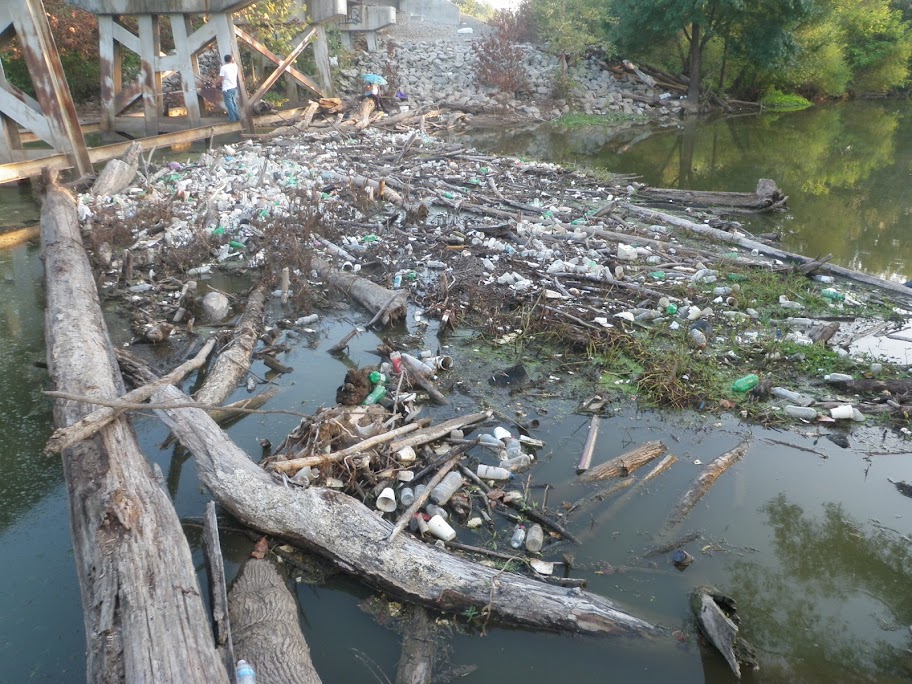I have always wondered about something, and I’m afraid the answer is again, no.
Each year, residents in Durham, North Carolina, where I live, participate in NC Big Sweep. This program dates back to 1987 when it became the nation’s first statewide clean up of waterways. This year 411 volunteers participated here, five fewer than last year.
Over the course of 15 miles of waterways on 23 different sites in Durham, these volunteers picked up 436 bags of debris, about 18% of which was recyclable.
There was less mileage covered this year, but twice the number of bags of trash retrieved.
This year they picked up 960 lbs. of bulk items that can’t be bagged, down from 13,533 lbs. last year but still this included 45 tires or 3-per-mile as well as items such as these:
toilet – radio – cane – plywood – sign - bike frame - 2 vacuum cleaners – rug - 4 florescent light tubes - 1 plastic crate - 5 bed mattresses/box springs - roll of wire fencing - carpet & padding - 6 TVs - 7 shopping carts - one newspaper stand – large road closure sign - 2 blankets - metal pole from street sign - wooden boards – plastic shelving unit two shelves high - 3 bicycle frames - a long metal strap (six feet) - wooden stool/furniture - orange cone - car tailpipe – signage - scrap iron – large rusted metal piece – planter - 2 basketballs - 1 basketball hoop base - one exercise ball - one door to a kids playhouse - 2 five gallon drums
My question this year, as it has been for the last four, is “will forensics be conducted on any of this material to identify perpetrators or at the very least understand some patterns that will inform strategies to curb the junking of these waterways in the future?
Things such as addresses, serial numbers, manufactures, as well as GPS tagging can help trace this litter back to perpetrators or close enough to send a signal that they aren’t invisible. The information could also be used to help position better lighting and even portable, wireless cameras to help with future identification.
Whenever I ask, both body language and comments from those involved portray a sense of futility that I am certain is common to other counties.
Crime overall (and what was found in these waterways is a crime)suffered from this phenomena until the mid-1970s when sociologists such as George L. Kelling persuaded law enforcement agencies to put “order” back in “law and order.”
Kelling, a professor emeritus at Rutgers and the late James. Q. Wilson coined the term “Broken Windows” in 1982 that has been largely responsible for the dramatic reduction in crime in many cities. It was based on the success they had in rejuvenating the New York Subway System by focusing on “appearance” as an overarching strategy.
Essentially, it involves eliminating minor crimes as a means to reduce major crime. Some police departments are dusting it off again as a way to reduce traffic accidents including those involving bicycles.
But it is astonishing to me how stubbornly resistant other agencies seem about adapting this now well-proven approach to the reduction of litter including the intentional pollution of waterways.
A friend told me recently that the parks and recreation department where I live has given up on repairing rest room fixtures because they will just be vandalized again. Another indicated that solid waste is reluctant to put blue recycling barrels (with two holes in the lid) in parks because they think people will put trash in them instead.
This makes little sense. About 10% of the stuff people put in recycling carts is trash anyway but recyclers have long ago figured out that it is easier to remove it than to let up on the effort to educate people to recycle.
The sense of futility that underlines this lack of determination to overcome the problems in parks is understandable at some level but infuriating at another.
We’re just going to give up and retreat or ask volunteers to slog out once a year and clean up a few miles? The answer is counterintuitive as it was for reducing major crime, but they both start with forensics to understand both the problem and the solution.
Kelling and Wilson were able to turn around the subway problem by persuading the authority that ran the system to focus on two things, a adopting zero tolerance for graffiti on cars and cracking down on people jumping turnstiles.
They did that by forensics. It turned out the people jumping turnstiles had outstanding warrants. I’ll bet there will be a linkage between criminal pollution of waterways and more serious crime here too.
It is worth a try, even if just to give hope and encouragement to volunteers trying to put a small dent in the mess along waterways.
No comments:
Post a Comment